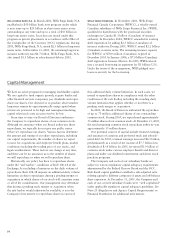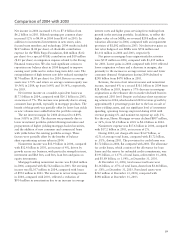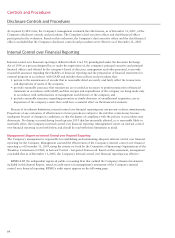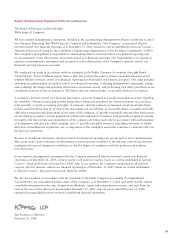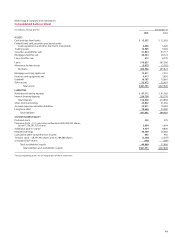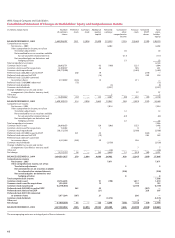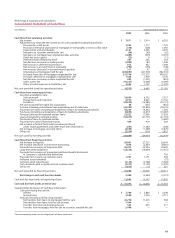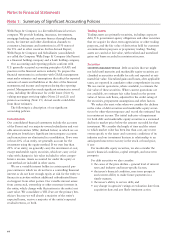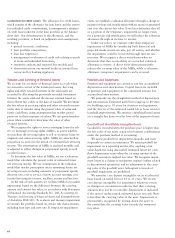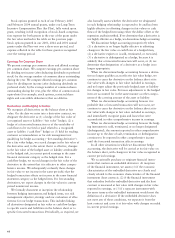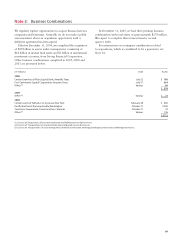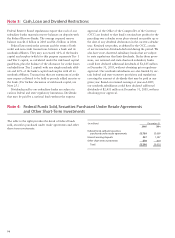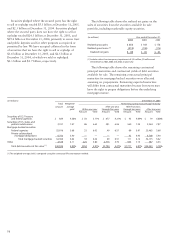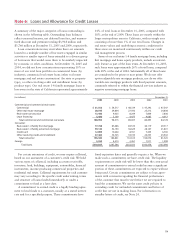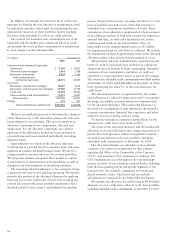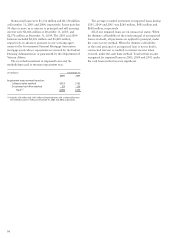Wells Fargo 2005 Annual Report Download - page 68
Download and view the complete annual report
Please find page 68 of the 2005 Wells Fargo annual report below. You can navigate through the pages in the report by either clicking on the pages listed below, or by using the keyword search tool below to find specific information within the annual report.
66
ALLOWANCE FOR CREDIT LOSSES The allowance for credit losses,
which consists of the allowance for loan losses and the reserve
for unfunded credit commitments, is management’s estimate
of credit losses inherent in the loan portfolio at the balance
sheet date. Our determination of the allowance, and the
resulting provision, is based on judgments and assumptions,
including:
• general economic conditions;
• loan portfolio composition;
• loan loss experience;
• management’s evaluation of credit risk relating to pools
of loans and individual borrowers;
• sensitivity analysis and expected loss models; and
• observations from our internal auditors, internal loan
review staff or banking regulators.
Transfers and Servicing of Financial Assets
We account for a transfer of financial assets as a sale when
we surrender control of the transferred assets. Servicing
rights and other retained interests in the sold assets are
recorded by allocating the previously recorded investment
between the assets sold and the interest retained based on
their relative fair values at the date of transfer. We determine
the fair values of servicing rights and other retained interests
at the date of transfer using the present value of estimated
future cash flows, using assumptions that market partici-
pants use in their estimates of values. We use quoted market
prices when available to determine the value of other
retained interests.
We recognize the rights to service mortgage loans for oth-
ers, or mortgage servicing rights (MSRs), as assets whether
we purchase the servicing rights or sell or securitize loans we
originate and retain servicing rights. MSRs are amortized in
proportion to, and over the period of, estimated net servicing
income. The amortization of MSRs is analyzed monthly and
is adjusted to reflect changes in prepayment speeds, as well
as other factors.
To determine the fair value of MSRs, we use a valuation
model that calculates the present value of estimated future
net servicing income. We use assumptions in the valuation
model that market participants use in estimating future net
servicing income, including estimates of prepayment speeds,
discount rate, cost to service, escrow account earnings, con-
tractual servicing fee income, ancillary income and late fees.
At the end of each quarter, we evaluate MSRs for possible
impairment based on the difference between the carrying
amount and current fair value, in accordance with Statement
of Financial Accounting Standards No. 140, Accounting for
Transfers and Servicing of Financial Assets and Extinguishments
of Liabilities (FAS 140). To evaluate and measure impairment
we stratify the portfolio based on certain risk characteristics,
including loan type and note rate. If temporary impairment
exists, we establish a valuation allowance through a charge to
income for those risk stratifications with an excess of amortized
cost over the current fair value. If we later determine that all
or a portion of the temporary impairment no longer exists
for a particular risk stratification, we will reduce the valuation
allowance through an increase to income.
Under our policy, we evaluate other-than-temporary
impairment of MSRs by considering both historical and
projected trends in interest rates, pay off activity and whether
the impairment could be recovered through interest rate
increases. We recognize a direct write-down when we
determine that the recoverability of a recorded valuation
allowance is remote. A direct write-down permanently
reduces the carrying value of the MSRs, while a valuation
allowance (temporary impairment) can be reversed.
Premises and Equipment
Premises and equipment are carried at cost less accumulated
depreciation and amortization. Capital leases are included
in premises and equipment at the capitalized amount less
accumulated amortization.
We primarily use the straight-line method of depreciation
and amortization. Estimated useful lives range up to 40 years
for buildings, up to 10 years for furniture and equipment,
and the shorter of the estimated useful life or lease term for
leasehold improvements. We amortize capitalized leased assets
on a straight-line basis over the lives of the respective leases.
Goodwill and Identifiable Intangible Assets
Goodwill is recorded when the purchase price is higher than
the fair value of net assets acquired in business combinations
under the purchase method of accounting.
We assess goodwill for impairment annually, and more
frequently in certain circumstances. We assess goodwill for
impairment on a reporting unit level by applying a fair-
value-based test using discounted estimated future net cash
flows. Impairment exists when the carrying amount of the
goodwill exceeds its implied fair value. We recognize impair-
ment losses as a charge to noninterest expense (unless related
to discontinued operations) and an adjustment to the carry-
ing value of the goodwill asset. Subsequent reversals of
goodwill impairment are prohibited.
We amortize core deposit intangibles on an accelerated
basis based on useful lives of 10 to 15 years. We review
core deposit intangibles for impairment whenever events
or changes in circumstances indicate that their carrying
amounts may not be recoverable. Impairment is indicated
if the sum of undiscounted estimated future net cash flows
is less than the carrying value of the asset. Impairment is
permanently recognized by writing down the asset to
the extent that the carrying value exceeds the estimated
fair value.


